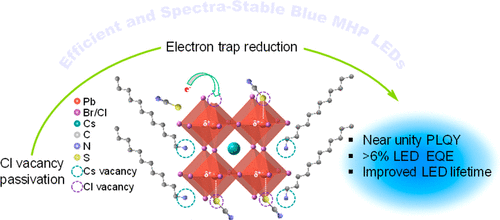当前位置:
X-MOL 学术
›
ACS Energy Lett.
›
论文详情
Our official English website, www.x-mol.net, welcomes your
feedback! (Note: you will need to create a separate account there.)
Chlorine Vacancy Passivation in Mixed Halide Perovskite Quantum Dots by Organic Pseudohalides Enables Efficient Rec. 2020 Blue Light-Emitting Diodes
ACS Energy Letters ( IF 19.3 ) Pub Date : 2020-02-17 , DOI: 10.1021/acsenergylett.0c00057 Xiaopeng Zheng 1 , Shuai Yuan 2 , Jiakai Liu 1 , Jun Yin 1 , Fanglong Yuan 3, 4 , Wan-Shan Shen 2 , Kexin Yao 1 , Mingyang Wei 3 , Chun Zhou 3 , Kepeng Song 1 , Bin-Bin Zhang 5 , Yuanbao Lin 6 , Mohamed Nejib Hedhili 7 , Nimer Wehbe 7 , Yu Han 1 , Hong-Tao Sun 5 , Zheng-Hong Lu 4 , Thomas D. Anthopoulos 6 , Omar F. Mohammed 1 , Edward H. Sargent 3 , Liang-Sheng Liao 2 , Osman M. Bakr 1
ACS Energy Letters ( IF 19.3 ) Pub Date : 2020-02-17 , DOI: 10.1021/acsenergylett.0c00057 Xiaopeng Zheng 1 , Shuai Yuan 2 , Jiakai Liu 1 , Jun Yin 1 , Fanglong Yuan 3, 4 , Wan-Shan Shen 2 , Kexin Yao 1 , Mingyang Wei 3 , Chun Zhou 3 , Kepeng Song 1 , Bin-Bin Zhang 5 , Yuanbao Lin 6 , Mohamed Nejib Hedhili 7 , Nimer Wehbe 7 , Yu Han 1 , Hong-Tao Sun 5 , Zheng-Hong Lu 4 , Thomas D. Anthopoulos 6 , Omar F. Mohammed 1 , Edward H. Sargent 3 , Liang-Sheng Liao 2 , Osman M. Bakr 1
Affiliation

|
Blue-emitting perovskites can be easily attained by precisely tuning the halide ratio of mixed halide (Br/Cl) perovskites (MHPs). However, the adjustable halide ratio hinders the passivation of Cl vacancies, the main source of trap states leading to inferior performance of blue MHP light-emitting diodes (LEDs). Here, we report a strategy for passivating Cl vacancies in MHP quantum dots (QDs) using nonpolar solvent-soluble organic pseudohalide [n-dodecylammonium thiocyanate (DAT)], enabling blue MHP LEDs with greatly enhanced efficiency. Density functional theory calculations reveal that the thiocyanate (SCN–) groups fill in the Cl vacancies and remove electron traps within the bandgap. DAT-treated CsPb(BrxCl1–x)3 QDs exhibit near unity (∼100%) photoluminescence quantum yields, and their blue (∼470 nm) LEDs are spectrally stable with an external quantum efficiency of 6.3%, a record for perovskite LEDs emitting in the range of 460–480 nm relevant to Rec. 2020 display standards, and a half-lifetime of ∼99 s.
中文翻译:

有机伪卤化物在混合卤化物钙钛矿量子点中的氯空位钝化可实现高效记录。2020蓝色发光二极管
通过精确调节混合卤化物(Br / Cl)钙钛矿(MHPs)的卤化物比率,可以轻松获得发出蓝色的钙钛矿。但是,可调节的卤化物比率会阻碍Cl空位的钝化,Cl空位是陷阱态的主要来源,导致蓝色MHP发光二极管(LED)的性能较差。在这里,我们报告了一种使用非极性溶剂可溶的有机假卤化物[ n-十二烷基硫氰酸铵(DAT)]钝化MHP量子点(QD)中Cl空位的策略,从而使蓝色MHP LED的效率大大提高。密度泛函理论计算表明,硫氰酸根(SCN –)基团填充了Cl空位并去除了带隙内的电子陷阱。DAT处理的CsPb(Br x Cl 1– x)3个QD表现出接近统一的(〜100%)光致发光量子产率,并且它们的蓝色(〜470 nm)LED光谱稳定,外部量子效率为6.3%,这是钙钛矿LED在460-480 nm范围内发射的记录至Rec。2020年显示标准,半衰期约为99秒。
更新日期:2020-02-17
中文翻译:

有机伪卤化物在混合卤化物钙钛矿量子点中的氯空位钝化可实现高效记录。2020蓝色发光二极管
通过精确调节混合卤化物(Br / Cl)钙钛矿(MHPs)的卤化物比率,可以轻松获得发出蓝色的钙钛矿。但是,可调节的卤化物比率会阻碍Cl空位的钝化,Cl空位是陷阱态的主要来源,导致蓝色MHP发光二极管(LED)的性能较差。在这里,我们报告了一种使用非极性溶剂可溶的有机假卤化物[ n-十二烷基硫氰酸铵(DAT)]钝化MHP量子点(QD)中Cl空位的策略,从而使蓝色MHP LED的效率大大提高。密度泛函理论计算表明,硫氰酸根(SCN –)基团填充了Cl空位并去除了带隙内的电子陷阱。DAT处理的CsPb(Br x Cl 1– x)3个QD表现出接近统一的(〜100%)光致发光量子产率,并且它们的蓝色(〜470 nm)LED光谱稳定,外部量子效率为6.3%,这是钙钛矿LED在460-480 nm范围内发射的记录至Rec。2020年显示标准,半衰期约为99秒。











































 京公网安备 11010802027423号
京公网安备 11010802027423号